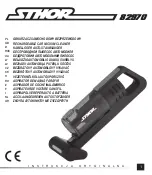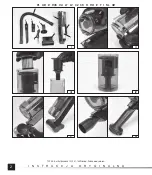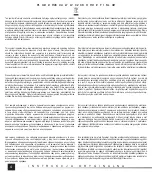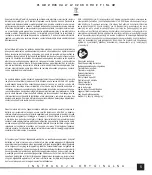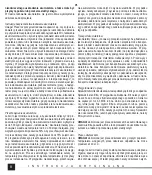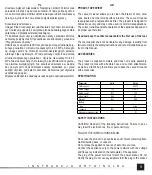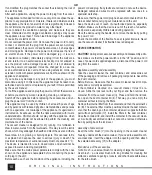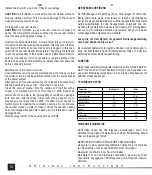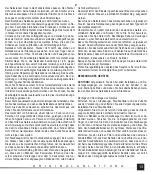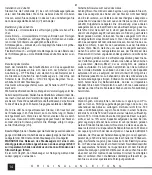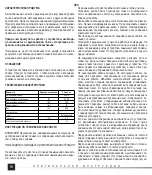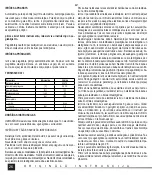
11
GB
O R I G I N A L I N S T R U C T I O N S
Crevice nozzle - intended for cleaning inaccessible places for larger
brushes.
Flexible hose - allows assembly of the oval brush or crevice nozzle
to increase the mobility of these accessories further.
Using the appliance
After assembling the dust container and the selected accessories,
make sure that the power switch is in the o
ff
position - OFF (VII),
then plug the power cord plug into the electrical system of the vehi-
cle. Turn the vacuum cleaner on by moving the power switch to the
on position - ON (VII), then start cleaning.
The vacuum cleaner is turned o
ff
when the power switch is set to
the o
ff
position - OFF.
Control the amount of dust in the container during operation. Place
the container in a vertical position with the lid pointing downwards.
The dust level should not be higher than the
fl
ange of the external
fi
lter, above which the perforated part of the
fi
lter begins. Empty the
container, if necessary.
If the LED does not light up when the plug is connected, and the
vacuum cleaner does not work, the fuse in the plug may burn out.
If this is the case, replace it with a new one. To do this, unscrew the
mounting ring, remove the plug contact and the fuse. Assemble in
reverse order (VIII).
The vacuum cleaner should be under supervision throughout the
charging process. Immediately after charging is complete, discon-
nect the charger from the mains and the vacuum cleaner from the
charger.
WARNING! Leaving the vacuum cleaner with a fully charged
battery connected to the charger will lead to irreparable dam-
age to the battery and may cause
fi
re or electric shock.
It is not possible to use a vacuum cleaner for cleaning while charging
the battery.
Safety instructions for battery charging
Caution! Before starting charging, make sure that the charger body,
cord and plug are not cracked or damaged. It is forbidden to use
a defective or damaged charger! Use only the supplied accessory
charger to charge the batteries. Use of another charger may result in
fi
re or damage to the device. The battery should only be charged in a
closed, dry room, protected against unauthorised access, especially
by children. Do not use the charger without the constant supervision
of an adult! If you need to leave the room where the vacuum clean-
er is being charged, disconnect the charger from the mains by re-
moving the charger plug from the socket. If smoke, odours, etc. are
escaping from the charger, remove the charger plug from the socket
immediately! The product is supplied with an uncharged battery and
should therefore be charged according to the procedure described in
the manual before use. Li-ion (lithium-ion) batteries do not have the
so-called “memory e
ff
ect”, which allows them to be recharged at any
time. However, it is recommended to discharge the battery during
normal operation and then charge it to full capacity. If, due to the
nature of work, it is not possible to use the battery in such a manner
every time, it should be done at least every several work cycles.
Never discharge the batteries by closing the battery contacts, as this
will cause irreparable damage! Also, do not check the battery charge
status by closing the contacts and checking sparking.
Battery storage
If possible, it is recommended to disconnect the battery from the
product for storage. Proper storage conditions will help to extend
the life of the battery. The battery lasts for about 500 charge-dis-
charge cycles. Store the battery in a temperature range from 0 to 30
degrees Celsius at a relative humidity of 50%. To store the battery
for a longer period of time, it should be charged to approx. 70%
of its capacity. In case of prolonged storage, the battery should be
periodically charged once a year. Do not over-discharge the bat-
tery as this will shorten its life and may cause irreparable damage.
During storage, the battery will gradually discharge due to leakage.
The self-discharge process depends on the storage temperature,
the higher the temperature, the faster the discharge process. If the
batteries are stored incorrectly, the electrolyte may leak. In case of
leakage, secure the leak with a neutralising agent, in case of elec-
trolyte contact with eyes, rinse eyes thoroughly with water, and seek
medical attention immediately. It is forbidden to use the device with
a damaged battery. If the battery is completely used, return it to a
specialist waste disposal centre.
Transport of batteries
Lithium-ion batteries are treated as hazardous materials according
to legal regulations. The user of the device can transport the prod-
uct with the battery and the batteries themselves by land. Additional
conditions do not have to be met. If you entrust transport to third
parties (e.g. courier service), follow the regulations for the transport
of hazardous goods. Before shipping, please contact a quali
fi
ed per-
son. It is forbidden to transport damaged batteries. During transport,
the disassembled batteries should be removed from the product,
the exposed contacts should be secured, e.g. sealed with insula-
tion tape. Protect the batteries in the packaging in such a way that
they do not move inside the packaging during transport. National
regulations for the transport of hazardous materials must also be
observed.
Preparing for operation
Check the vacuum cleaner tank, empty it of waste, if necessary.
Check the
fi
lter. If the
fi
lter is dirty, dry clean with a compressed
air stream of no more than 0.3 MPa or wet under a stream of run-
ning, lukewarm water. Do not clean the
fi
lter in dishwashers or with
a high-pressure water jet. If dirt cannot be removed from the
fi
lter,
replace it with a new one. Check the condition of the
fi
lter seals,

